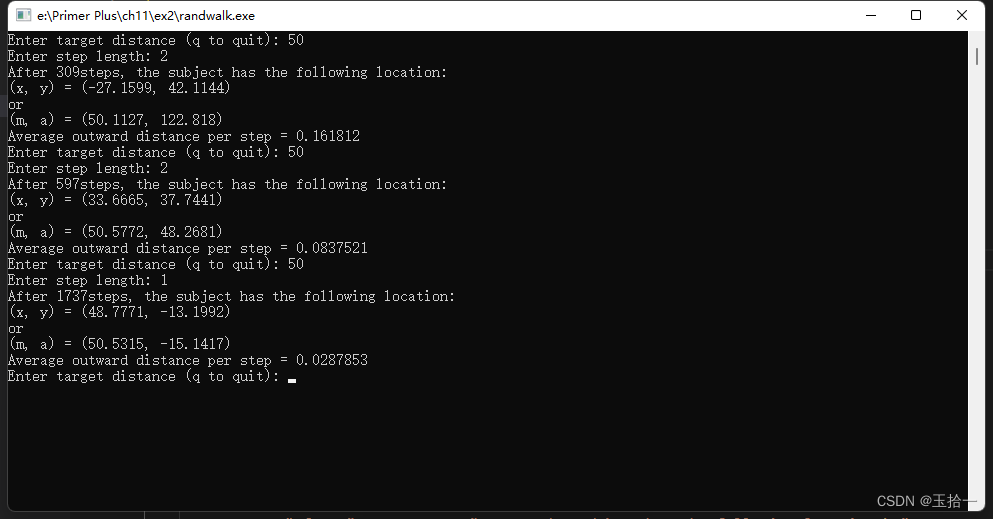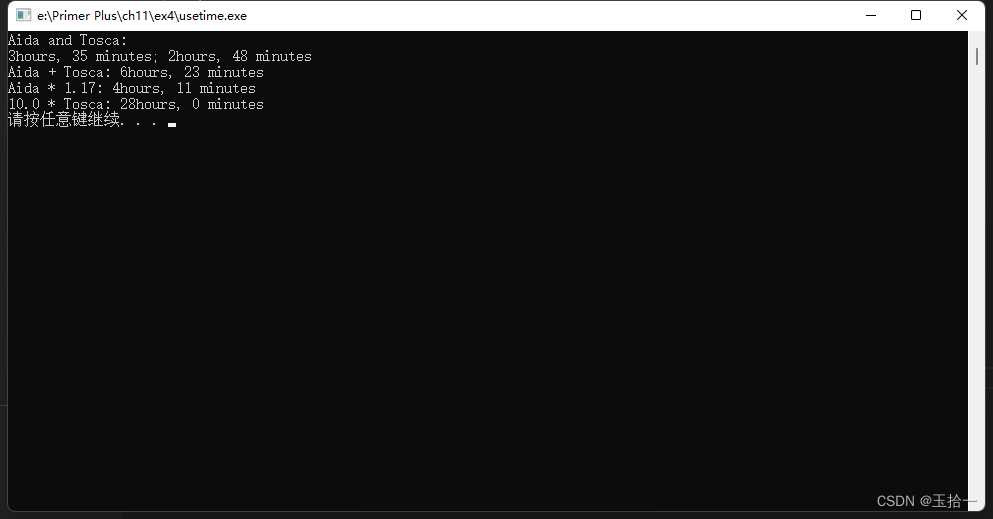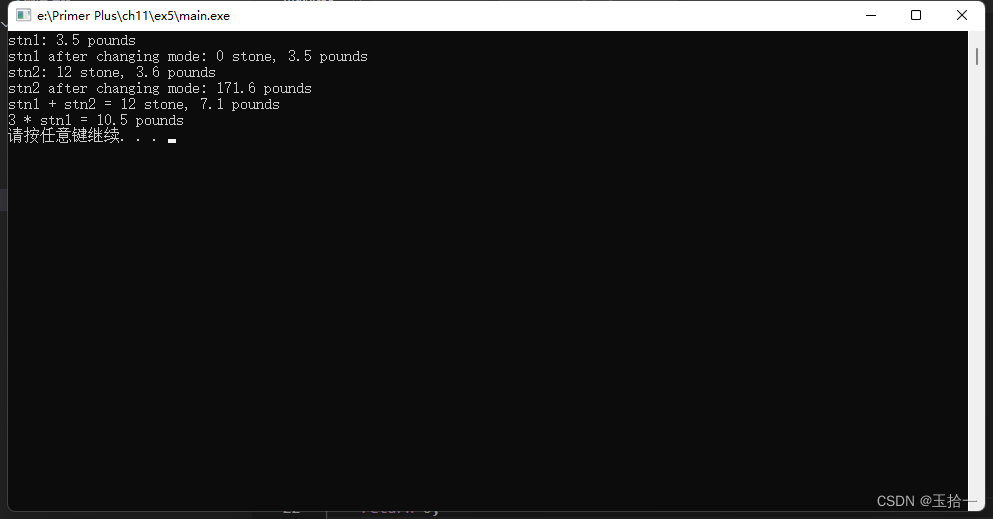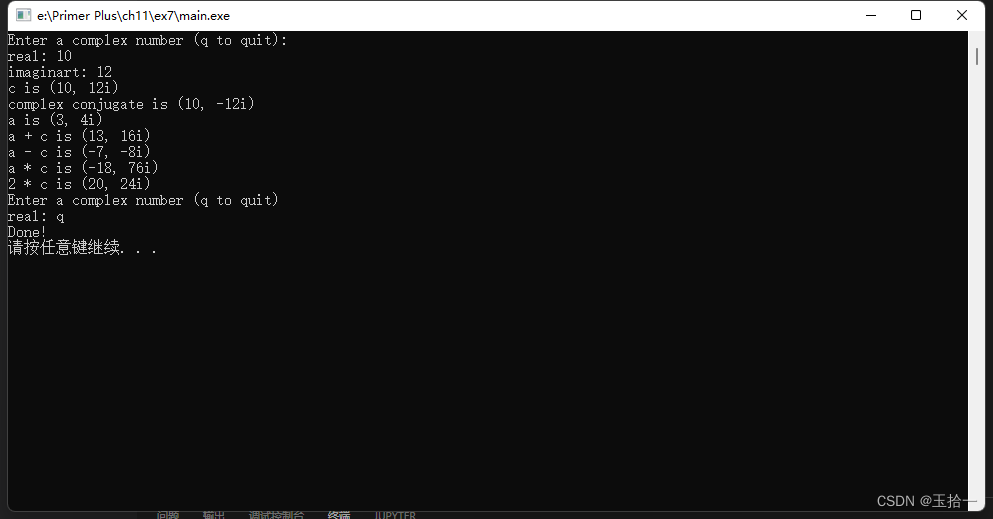1. 修改程序清单11.15,使之将一系列连续的随机漫步者位置写入到文件中。对于每个位置,用步号进行标示。另外,让该程序将初始条件(目标距离和步长)以及结果小结写入到该文件中。
本题目与程序清单11.13,11.14和11.15相比较,主要改动为将在控制台输出改为了输出在文件中,由于程序本身已经重载了<<运算符,osteram是ofstream的基类,因此ofstream对象可以直接调用重载后的<<运算符。故vector.h和vector.cpp文件都不需要进行修改。
vector.h文件
#ifndef VECTOR_H
#define VECTOR_H
#include <iostream>
#include <fstream>
namespace VECTOR
{
class Vector
{
public:
enum Mode {RECT, POL};
private:
Mode mode;
// RECT mode
double x;
double y;
// POL mode
double mag;
double ang;
// private methods for setting values
void SetMag();
void SetAng();
void SetX();
void SetY();
public:
Vector();
Vector(double n1, double n2, Mode form = RECT);
void Reset(double n1, double n2, Mode form = RECT);
~Vector() {};
// report value
double Xval() const {return x;}
double Yval() const {return y;}
double MagVal() const {return mag;}
double AngVal() const {return ang;}
// change mode
void PolarMode();
void RectMode();
// operator overloading
Vector operator+(const Vector & b) const;
Vector operator-(const Vector & b) const;
Vector operator-() const;
Vector operator*(double n) const;
// friend
friend Vector operator*(double n, const Vector & b);
friend std::ostream & operator<<(std::ostream & os, const Vector & v);
};
} // namespace VECTOR
#endifvector.cpp文件
#include <cmath>
#include "vector.h"
using std::sqrt;
using std::sin;
using std::cos;
using std::atan;
using std::atan2;
using std::cout;
namespace VECTOR
{
const double Rad_to_Deg = 45.0 / atan(1.0);
// private methods
void Vector::SetMag()
{
mag = sqrt(x * x + y * y);
}
void Vector::SetAng()
{
if (x == 0.0 && y == 0.0)
ang = 0.0;
else
ang = atan2(y, x);
}
void Vector::SetX()
{
x = mag * cos(ang);
}
void Vector::SetY()
{
y = mag * sin(ang);
}
// public methods
Vector::Vector() // default constructor
{
x = y = mag = ang = 0.0;
mode = RECT;
}
Vector::Vector(double n1, double n2, Mode form)
{
mode = form;
if (mode == RECT)
{
x = n1;
y = n2;
SetMag();
SetAng();
}
else if (mode == POL)
{
mag = n1;
ang = n2 / Rad_to_Deg;
SetX();
SetY();
}
else
{
cout << "Incorrect 3rd argument to Vector() -- ";
cout << "vector set to 0\n";
x = y = mag = ang = 0.0;
mode = RECT;
}
}
void Vector::Reset(double n1, double n2, Mode form)
{
mode = form;
if (mode == RECT)
{
x = n1;
y = n2;
SetMag();
SetAng();
}
else if (mode == POL)
{
mag = n1;
ang = n2 / Rad_to_Deg;
SetX();
SetY();
}
else
{
cout << "Incorrect 3rd argument to Vector() -- ";
cout << "vector set to 0\n";
x = y = mag = ang = 0.0;
mode = RECT;
}
}
void Vector::PolarMode()
{
mode = POL;
}
void Vector::RectMode()
{
mode = RECT;
}
// operator overloading
Vector Vector::operator+(const Vector & b) const
{
return Vector(x + b.x, y + b.y);
}
Vector Vector::operator-(const Vector & b) const
{
return Vector(x - b.x, y - b.y);
}
Vector Vector::operator-() const
{
return Vector(-x, -y);
}
Vector Vector::operator*(double n) const
{
return Vector(n * x, n * y);
}
// friend methods
Vector operator*(double n, const Vector & b)
{
return b * n;
}
// ostream << overloading
std::ostream & operator<<(std::ostream & os, const Vector & v)
{
if (v.mode == Vector::RECT)
{
os << "(x, y) = (" << v.x << ", " << v.y << ")";
}
else if (v.mode == Vector::POL)
{
os << "(m, a) = (" << v.mag << ", " << v.ang * Rad_to_Deg << ")";
}
else
os << "Vector object mode is invalid";
return os;
}
} // namespace VECTOR
11.15 randwalk.cpp文件中,需要将ostream对象修改为ofstream即可。
#include <iostream>
#include <cstdlib>
#include <ctime>
#include "vector.h"
int main()
{
using namespace std;
using VECTOR::Vector;
srand(time(0));
double direction; // random direction
Vector step; // each strp
Vector result(0.0, 0.0); // result positon
unsigned long steps = 0; // total steps
double target; //target length
double dstep;
// write into file "save.txt"
ofstream ofs;
ofs.open("save.txt");
// walk started
cout << "Enter target distance (q to quit): ";
while (cin >> target && target != 'q')
{
cout << "Enter step length: ";
if (!(cin >> dstep))
break;
ofs << "Target Distance: " << target << ", " << "Step Size: " << dstep << std::endl;
while (result.MagVal() < target)
{
ofs << steps << ": " << result << std::endl;
direction = rand() % 360;
step.Reset(dstep, direction, Vector::POL);
result = result + step;
steps ++;
}
ofs << "After " << steps << "steps, the subject has the following location:\n";
ofs << result << std::endl;
ofs << "or" << std::endl;
result.PolarMode();
ofs << result << std::endl;
ofs << "Average outward distance per step = " << target / steps << std::endl;
steps = 0;
result.Reset(0.0, 0.0);
cout << "Enter target distance (q to quit): ";
}
cout << "Bye!\n";
cin.clear();
while (cin.get() != '\n')
continue;
system("pause");
return 0;
}程序输出保存在当前目录下的save.txt文件中

2. 对Vector类的头文件(程序清单 11.13)和实现文件(程序清单 11.14)进行修改,使其不再存储矢量的长度和角度,而是在magval()和angval()被调用时计算它们。
由于题目要求在vector.h头文件中不再存储矢量长度和角度,所以需要删除两个成员变量mag和ang,以及SetMag()和SetAng()两个函数。同时修改内联函数MagVal()和AngVal()使其不再返回成员变量的值,而是返回长度和角度的计算结果。
#ifndef VECTOR_H
#define VECTOR_H
#include <iostream>
#include <fstream>
#include <cmath>
namespace VECTOR
{
class Vector
{
public:
enum Mode {RECT, POL};
private:
Mode mode;
// RECT mode
double x;
double y;
// // POL mode
// double mag;
// double ang;
// private methods for setting values
// double SetMag();
// double SetAng();
void SetX(double mag, double ang);
void SetY(double mag, double ang);
public:
Vector();
Vector(double n1, double n2, Mode form = RECT);
void Reset(double n1, double n2, Mode form = RECT);
~Vector() {};
// report value
double Xval() const {return x;}
double Yval() const {return y;}
double MagVal() const
{
return sqrt(x * x + y * y);
}
double AngVal() const
{
if (x == 0.0 && y == 0.0)
return 0.0;
else
return atan2(y, x);
}
// change mode
void PolarMode();
void RectMode();
// operator overloading
Vector operator+(const Vector & b) const;
Vector operator-(const Vector & b) const;
Vector operator-() const;
Vector operator*(double n) const;
// friend
friend Vector operator*(double n, const Vector & b);
friend std::ostream & operator<<(std::ostream & os, const Vector & v);
};
} // namespace VECTOR
#endif在vector.cpp文件中需要修改的是
- 删除SetMag()以及SetAng()的成员函数定义
- 修改构造函数和Reset()成员函数,如果传入RECT参数,则仅保存x,y坐标,如果传入POL参数,则将矢量长度和角度转换后的x,y坐标保存在成员变量中
#include "vector.h"
using std::sqrt;
using std::sin;
using std::cos;
using std::atan;
using std::atan2;
using std::cout;
namespace VECTOR
{
const double Rad_to_Deg = 45.0 / atan(1.0);
// private methods
// double Vector::SetMag()
// {
// return MagVal();
// }
// double Vector::SetAng()
// {
// return AngVal();
// }
void Vector::SetX(double mag, double ang)
{
x = mag * cos(ang);
}
void Vector::SetY(double mag, double ang)
{
y = mag * sin(ang);
}
// public methods
Vector::Vector() // default constructor
{
x = y = 0.0;
mode = RECT;
}
Vector::Vector(double n1, double n2, Mode form)
{
mode = form;
if (mode == RECT)
{
x = n1;
y = n2;
// SetMag();
// SetAng();
}
else if (mode == POL)
{
double mag = n1;
double ang = n2 / Rad_to_Deg;
SetX(mag, ang);
SetY(mag, ang);
}
else
{
cout << "Incorrect 3rd argument to Vector() -- ";
cout << "vector set to 0\n";
x = y = 0.0;
mode = RECT;
}
}
void Vector::Reset(double n1, double n2, Mode form)
{
mode = form;
if (mode == RECT)
{
x = n1;
y = n2;
// SetMag();
// SetAng();
}
else if (mode == POL)
{
double mag = n1;
double ang = n2 / Rad_to_Deg;
SetX(mag, ang);
SetY(mag, ang);
}
else
{
cout << "Incorrect 3rd argument to Vector() -- ";
cout << "vector set to 0\n";
x = y = 0.0;
mode = RECT;
}
}
void Vector::PolarMode()
{
mode = POL;
}
void Vector::RectMode()
{
mode = RECT;
}
// operator overloading
Vector Vector::operator+(const Vector & b) const
{
return Vector(x + b.x, y + b.y);
}
Vector Vector::operator-(const Vector & b) const
{
return Vector(x - b.x, y - b.y);
}
Vector Vector::operator-() const
{
return Vector(-x, -y);
}
Vector Vector::operator*(double n) const
{
return Vector(n * x, n * y);
}
// friend methods
Vector operator*(double n, const Vector & b)
{
return b * n;
}
// ostream << overloading
std::ostream & operator<<(std::ostream & os, const Vector & v)
{
if (v.mode == Vector::RECT)
{
os << "(x, y) = (" << v.x << ", " << v.y << ")";
}
else if (v.mode == Vector::POL)
{
os << "(m, a) = (" << v.MagVal() << ", " << v.AngVal() * Rad_to_Deg << ")";
}
else
os << "Vector object mode is invalid";
return os;
}
} // namespace VECTOR
程序清单11.15提供的randwalk.cpp文件不进行改动,用于测试程序结果

3. 修改程序清单11.15,使之报告N次测试中的最高、最低和平均数,而不是报告每次测试的结果。
本题目考察内容与类使用并无太大关联,只需要增加三个变量用于在循环中统计最高、最低和平均数即可。
4. 重新编写最后的Time类实例(程序清单11.10、程序清单11.11和程序清单11.12),使用友元函数来实现所有的重载运算符。
友元函数在类中进行声明,但是在源文件中定义的时候不需要在函数前添加类限定符::,但是需要在参数中添加类对象作为形参之一,表示该运算符作用的对象。
头文件mytime.h
#ifndef MYTIME_H
#define MYTIME_H
#include <iostream>
class Time
{
private:
int hours;
int minutes;
public:
Time();
Time(int h, int m = 0);
void AddMin(int m);
void AddHr(int h);
void Reset(int h = 0, int m = 0);
friend Time operator+(const Time & t1, const Time & t2);
friend Time operator-(const Time & t1, const Time & t2);
friend Time operator*(double mult, const Time & t);
friend Time operator*(const Time & t, double mult)
{
return mult * t;
}
friend std::ostream & operator<<(std::ostream & os, const Time & t);
};
#endif在源文件mytime.cpp中队成员函数进行定义,针对小时和分钟运算使用到的思想,主要是将传入的时间对象统一转化为单位较小的分钟,针对折算成的总minutes值进行运算,将结果再转为标准的小时,分钟格式。
#include "mytime.h"
Time::Time()
{
hours = minutes = 0;
};
Time::Time(int h, int m)
{
hours = h;
minutes = m;
}
void Time::AddMin(int m)
{
minutes += m;
hours += minutes / 60;
minutes = minutes % 60;
}
void Time::AddHr(int h)
{
hours += h;
}
void Time::Reset(int h, int m)
{
hours = h;
minutes = m;
}
Time operator+(const Time & t1, const Time & t2)
{
Time result;
result.minutes = t1.minutes + t2.minutes;
result.hours = t1.hours + t2.hours + result.minutes / 60;
result.minutes = result.minutes % 60;
return result;
}
Time operator-(const Time & t1, const Time & t2)
{
Time result;
int tot1, tot2;
tot1 = t1.minutes + 60 * t1.hours;
tot2 = t2.minutes + 60 * t2.hours;
result.minutes = (tot1 - tot2) % 60;
result.hours = (tot1 - tot2) / 60;
return result;
}
Time operator*(double mult, const Time & t)
{
Time result;
long totalMinutes = t.hours * 60 * mult + t.minutes * mult;
result.minutes = totalMinutes % 60;
result.hours = totalMinutes / 60;
return result;
}
std::ostream & operator<<(std::ostream & os, const Time & t)
{
os << t.hours << "hours, " << t.minutes << " minutes";
return os;
}用于测试程序的文件usetime.cpp相较于程序清单11.2没有改动,运行结果也保持一致

5. 重新编写Stonewt类(程序清单11.16和程序清单11.17),使它有一个状态成员,由该成员控制对象应转换为英石格式、整数磅格式还是浮点磅格式。重载<<运算符,使用它来替换show_stn()和show_lbs()方法。重载加法、减法和乘法运算符,以便可以对Stonewt值进行加、减、乘运算。编写一个使用所有类方法和友元的小程序,来测试这个类。
头文件stonewt.h主要改动为
- 使用枚举增加状态成员Mode,用于表示(英石+磅)和(磅)两种重量的表达方式
- 成员函数ToPds()和ToStnPds()分别用于将对象转换为(磅)或者(英石+磅)两种格式
- 使用友元函数对<<\+、-、*运算符进行重载
#ifndef STONEWT_H
#define STONEWT_H
#include <iostream>
class Stonewt
{
private:
enum {Lbs_per_stn = 14};
enum Mode {STN_PDS, PDS};
int stone;
double pdsLeft;
double pounds;
Mode mode;
public:
Stonewt(double lbs);
Stonewt(int stn, double lbs);
Stonewt();
~Stonewt() {};
void ToPds();
void ToStnPds();
friend std::ostream & operator<<(std::ostream & os, Stonewt & stn);
friend Stonewt operator+(Stonewt & stn1, Stonewt & stn2);
friend Stonewt operator-(Stonewt & stn1, Stonewt & stn2);
Stonewt operator*(double n) const;
friend Stonewt operator*(double n, Stonewt & stn)
{
return stn * n;
}
};
#endif在成员函数的定义文件stonewt.cpp中,针对+、-和*运算,用到了同样的计算方式,即将对象数值统一转换为单位较小的浮点数,对该浮点数计算得到的结果在进行转换,换为标准格式。
#include "stonewt.h"
using std::cout;
// default constructor
Stonewt::Stonewt()
{
stone = pdsLeft = pounds = 0;
mode = STN_PDS;
}
// construct Stonewt object from double value
Stonewt::Stonewt(double lbs)
{
mode = PDS;
stone = int (lbs) / Lbs_per_stn;
pdsLeft = int (lbs) % Lbs_per_stn + lbs - int (lbs);
pounds = lbs;
}
// construct Stonewt object from stone, double value
Stonewt::Stonewt(int stn, double lbs)
{
mode = STN_PDS;
stone = stn;
pdsLeft = lbs;
pounds = stn * Lbs_per_stn + lbs;
}
void Stonewt::ToPds()
{
mode = PDS;
}
void Stonewt::ToStnPds()
{
mode = STN_PDS;
}
std::ostream & operator<<(std::ostream & os, Stonewt & stn)
{
if (stn.mode == Stonewt::STN_PDS)
{
os << stn.stone << " stone, " << stn.pdsLeft << " pounds";
}
else if (stn.mode == Stonewt::PDS)
{
os << stn.pounds << " pounds";
}
else
{
os << "Invalid object";
}
return os;
}
Stonewt operator+(Stonewt & stn1, Stonewt & stn2)
{
Stonewt result;
result.pounds = stn1.pounds + stn2.pounds;
result.stone = int (result.pounds) / 14;
result.pdsLeft = int (result.pounds) % 14 + result.pounds - int (result.pounds);
return result;
}
Stonewt operator-(Stonewt & stn1, Stonewt & stn2)
{
double pounds;
pounds = stn1.pounds - stn2.pounds;
Stonewt diff(pounds);
return diff;
}
Stonewt Stonewt::operator*(double n) const
{
return Stonewt(n * pounds);
}在main.cpp测试该程序
#include <iostream>
#include "stonewt.h"
int main()
{
using std::cout;
using std::endl;
Stonewt stn1(3.5);
Stonewt stn2(12, 3.6);
cout << "stn1: " << stn1 << endl;
stn1.ToStnPds();
cout << "stn1 after changing mode: " << stn1 << endl;
cout << "stn2: " << stn2 << endl;
stn2.ToPds();
cout << "stn2 after changing mode: " << stn2 << endl;
Stonewt sum = stn1 + stn2;
cout << "stn1 + stn2 = " << sum << endl;
Stonewt mult = 3 * stn1;
cout << "3 * stn1 = " << mult << endl;
system("pause");
return 0;
}
运行结果

7. 复数有两个部分组成:实数部分和虚数部分。请定义一个复数类,以便下面的程序可使它来获得正确的结果
复数的定义和计算原理题目已经给出,所以我就直接贴代码了
conplex0.h
#ifndef COMPLEX0_H
#define COMPLEX0_H
#include <iostream>
class Complex
{
private:
double real;
double imaginary;
public:
Complex();
Complex(double r, double i);
~Complex() {};
friend Complex operator+(const Complex & c1, const Complex & c2);
friend Complex operator-(const Complex & c1, const Complex & c2);
friend Complex operator*(const Complex & c1, const Complex & c2);
friend Complex operator*(double x, const Complex & c);
friend Complex operator~(const Complex & c);
friend std::ostream & operator<<(std::ostream & os, const Complex & c);
friend std::istream & operator>>(std::istream & os, Complex & c);
};
#endifcomplex0.cpp
#include "complex0.h"
Complex::Complex()
{
real = imaginary = 0.0;
}
Complex::Complex(double r, double i)
{
real = r;
imaginary = i;
}
Complex operator+(const Complex & c1, const Complex & c2)
{
return Complex(c1.real + c2.real, c1.imaginary + c2.imaginary);
}
Complex operator-(const Complex & c1, const Complex & c2)
{
return Complex(c1.real - c2.real, c1.imaginary - c2.imaginary);
}
Complex operator*(const Complex & c1, const Complex & c2)
{
return Complex(c1.real * c2.real - c1.imaginary * c2.imaginary,
c1.real * c2.imaginary + c1.imaginary * c2.real);
}
Complex operator*(double x, const Complex & c)
{
return Complex(x * c.real, x * c.imaginary);
}
Complex operator~(const Complex & c)
{
return Complex(c.real, -c.imaginary);
}
std::ostream & operator<<(std::ostream & os, const Complex & c)
{
os << "(" << c.real << ", " << c.imaginary << "i)";
return os;
}
std::istream & operator>>(std::istream & is, Complex & c)
{
using std::cout;
cout << "real: ";
is >> c.real;
if (!is)
return is;
cout << "imaginart: ";
is >> c.imaginary;
return is;
}
使用题目给出的代码对程序进行测试,输出结果与预期一致
#include <iostream>
#include "complex0.h"
using namespace std;
int main()
{
Complex a(3.0, 4.0);
Complex c;
cout << "Enter a complex number (q to quit):\n";
while (cin >> c)
{
cout << "c is " << c << endl;
cout << "complex conjugate is " << ~c << endl;
cout << "a is " << a << endl;
cout << "a + c is " << a + c << endl;
cout << "a - c is " << a - c << endl;
cout << "a * c is " << a * c << endl;
cout << "2 * c is " << 2 * c << endl;
cout << "Enter a complex number (q to quit)" << endl;
}
cout << "Done!\n";
system("pause");
return 0;
}






















 689
689











 被折叠的 条评论
为什么被折叠?
被折叠的 条评论
为什么被折叠?








